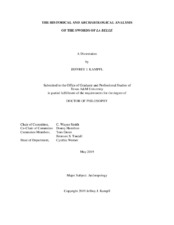| dc.description.abstract | ABSTRACT
This research involves the conservation, historical and archaeological analysis of a cache of swords recovered from the 17th-century French shipwreck La Belle. The central premise of my research model is the incorporation of the theories and methodologies of several convergent disciplines; concentrating on the material and cultural aspect of these weapons, and the technical processes involved with their conservation. The integration of the conservation process and research results with the archaeological evidence, both objects and context, can lead to new methods of archaeological inquiry. The details of materials composition and structure, sequence of processing, properties, performance, or use should define the way modern material culture research is conducted.
This research approach seeks to answer such relevant questions as what is the past and current history of the sword types recovered from La Belle? What materials, technology or skilled craft aided in the production of these swords and their individual components? What was the practical and symbolic function of these edged weapons? Subsequently, the data lead to interpretations of the finds and their broader meaning within the context of the shipwreck itself. I am convinced that the research presented in this dissertation will help to facilitate a wider dialogue about swords and other edged weapons among weapons historians and archaeologists.
The conservator is dedicated to maintaining the long-term preservation of cultural artifacts through examination, documentation, treatment, and preventive care and research. Conservation is an interdisciplinary field involving knowledge and skills acquired from a number of diverse disciplines in the arts and sciences. As a result, conservators must have a working knowledge of materials technology, chemistry, biology, physics, art history, and archaeology.
The results of the case studies discussed in chapter six, though limited in scope, proved most promising, indicating that there are always viable alternatives to the methods and materials used by artifact conservation and preservation. The collaboration between conservators and experts in other related fields, such as conservation science, computer science, radiography, digital imaging, and rapid-prototyping technology is critical to the successful practice of artifact conservation and interpretation. | en |


